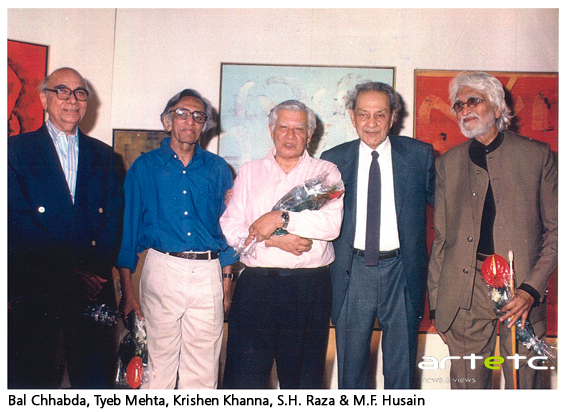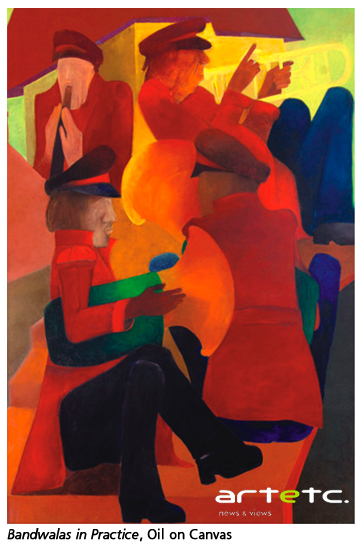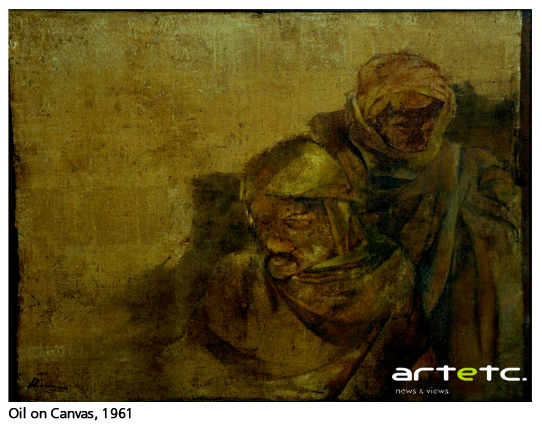- Publisher's Note
- Editorial
- The Enigma That was Souza
- Progressive Art Group Show: The Moderns
- The Souza Magic
- M.F. Husain: Other Identities
- From All, One; And From One, All
- Tyeb Mehta
- Akbar Padamsee: The Shastra of Art
- Sensuous Preoccupations of V.S. Gaitonde
- Manishi Dey: The Elusive Bohemian
- Krishen Khanna: The Fauvist Progressive
- Ram Kumar: Artistic Intensity of an Ascetic
- The Unspoken Histories and Fragment: Bal Chhabda
- P. A. G. and the Role of the Critics
- Group 1890: An Antidote for the Progressives?
- The Subversive Modernist: K.K.Hebbar
- Challenging Conventional Perceptions of African Art
- 40 Striking Indian Sculptures at Peabody Essex Museum
- Tibetan Narrative Paintings at Rubin Museum
- Two New Galleries for the Art of Asia opens at the Museum of Fine Arts in Boston
- Raphael, Botticelli and Titian at the National Gallery of Australia
- The Economics of Patronization
- And Then There Was Zhang and Qi
- What Happened and What's Forthcoming
- Random Strokes
- Yinka Shonibare: Lavishly Clothing the Somber History
- A Majestic “Africa”: El Anatsui's Wall Hangings
- The Idea of Art, Participation and Change in Pistoletto’s Work
- On Wings of Sculpted Fantasies
- The Odysseus Journey into Time in the Form of Art
- On Confirming the Aesthetic of Spectacle: Vidya Kamat at the Guild Mumbai
- Dhiraj Choudhury: Artist in Platinum Mode
- Emerging from the Womb of Consciousness
- Gary Hume - The Indifferent Owl at the White Cube, London
- Daum Nancy: A Brief History
- Experimenting with New Spatial Concepts – The Serpentine Gallery Pavilion Project
- A Rare Joie De Vivre!
- Art Events Kolkata-December 2011– January 2012
- Art Bengaluru
- Mumbai Art Sighting
- Delhi Dias
- Musings from Chennai
- Preview, February, 2012- March, 2012
- In the News-January 2012
ART news & views
Krishen Khanna: The Fauvist Progressive
Issue No: 25 Month: 2 Year: 2012
by Nuzhat Kazmi
 It is with some deliberations that I have taken the decision to address Krishen Khanna, the fauvist progressive. Without doubt a modernist, an artist who understood and explored the modernist attitude and not just because he was exposed to western education and cultural milieu, but also because of, I would say, having experienced the explosive demolition of feudal and colonial edifice. This happened, in Krishen's case, right when the World War II came and brought to the forefront the political modernist values and world view, now seen not only the privilege of the Europeans but indeed possible where the people had the will to claim it. Born in 1925 in Lyallpur, now Faisalabad in Pakistan, Krishen's a life is marked by all the turns and twists of the India sub-continent, as it was historically played out, during the gathering of the Indian Nationalist Movement. Krishen saw it all, the freedom struggle of the colonized Indians and also through the tragic, tumultuous partition of a nation into two. He saw the World War II, the wars India fought with China, Pakistan and yes those fought in Afghanistan and Baghdad, reminding that unjust colonization exists, brutal imperialism thrives, unfortunately, in great parts of the world. Modernity, as such, remains a poet's dream, an artist's vision. Values of freedom, liberty and equality were still a fight for many people of the world. Krishen Khanna has been acutely sensitive to this historical and its contemporary manifestations. This sensitivity and its articulation pervade nearly all his artistic endeavours.
It is with some deliberations that I have taken the decision to address Krishen Khanna, the fauvist progressive. Without doubt a modernist, an artist who understood and explored the modernist attitude and not just because he was exposed to western education and cultural milieu, but also because of, I would say, having experienced the explosive demolition of feudal and colonial edifice. This happened, in Krishen's case, right when the World War II came and brought to the forefront the political modernist values and world view, now seen not only the privilege of the Europeans but indeed possible where the people had the will to claim it. Born in 1925 in Lyallpur, now Faisalabad in Pakistan, Krishen's a life is marked by all the turns and twists of the India sub-continent, as it was historically played out, during the gathering of the Indian Nationalist Movement. Krishen saw it all, the freedom struggle of the colonized Indians and also through the tragic, tumultuous partition of a nation into two. He saw the World War II, the wars India fought with China, Pakistan and yes those fought in Afghanistan and Baghdad, reminding that unjust colonization exists, brutal imperialism thrives, unfortunately, in great parts of the world. Modernity, as such, remains a poet's dream, an artist's vision. Values of freedom, liberty and equality were still a fight for many people of the world. Krishen Khanna has been acutely sensitive to this historical and its contemporary manifestations. This sensitivity and its articulation pervade nearly all his artistic endeavours.
Krishen, a progressive group artist, was inducted into the avant-garde movement by his friends and fellow modernist ideologues, M.F. Husain, Akbar Padamsee and Tyeb Mehta. He is indeed the artist, along with others just mentioned, who translated contemporary historical happenings, as these touched the common man's living, his daily hard ground realities. And Krishen has done that with a keen sense of the political implications involved therein.

When the Indian partition took place, Krishen with his family moved to Shimla. He subsequently moved to Bombay, to Kanpur and then to Delhi. He is now living in Gurgaon, close to Delhi, from where he moved some years ago to a house designed by his architect son, Karan. Now eighty six, he is actively engaged with the creative obsession, that is painting, with the same passion as he did, when he resigned from his job with the Grindlays Bank in order to pursue it with complete abandon. Much like, if I may draw a comparison, Paul Gauguin, the post impressionist Modern, did in the late nineteenth century to escape the growing disillusionment with the European civilization as it was manifesting itself in that century.
 Going to the time of unpartitioned India, Krishen Khanna had attended the evening classes at the Mayo School of Art in Lahore, now National College of Art. Here was the happening art scene, which was getting increasingly knotted with the growing political nationalist uprising. Lahore was also the city where B.C. Sanyal and Amrita Sher Gil among others had lived and worked. Krishen Khanna, later, graduated from the Imperial Service College, Windsor, England, in 1940. After arriving in India he took up a post with the Grindlays Bank and was placed in the city of Bombay. Krishen was inducted into the Progressive Artists` Group by M.F. Husain, who was to remain his lifelong friend. Krishen Khanna remembers that his painting had been displayed in the centre of the PAG exhibition. Other artists showing were K.K. Hebbar, V.S. Gaitonde, F.N. Souza and S.H. Raza. “I told Raza his painting was terrible,” Khanna recalls and of his own painting he has this to say, ”My painting, a bleak representation of people receiving the news of Gandhi's assassination, drew the attention of the visitors, however the newspapers had this to report the next day, “Husain is a painter to be watched”, he exclaimed!
Going to the time of unpartitioned India, Krishen Khanna had attended the evening classes at the Mayo School of Art in Lahore, now National College of Art. Here was the happening art scene, which was getting increasingly knotted with the growing political nationalist uprising. Lahore was also the city where B.C. Sanyal and Amrita Sher Gil among others had lived and worked. Krishen Khanna, later, graduated from the Imperial Service College, Windsor, England, in 1940. After arriving in India he took up a post with the Grindlays Bank and was placed in the city of Bombay. Krishen was inducted into the Progressive Artists` Group by M.F. Husain, who was to remain his lifelong friend. Krishen Khanna remembers that his painting had been displayed in the centre of the PAG exhibition. Other artists showing were K.K. Hebbar, V.S. Gaitonde, F.N. Souza and S.H. Raza. “I told Raza his painting was terrible,” Khanna recalls and of his own painting he has this to say, ”My painting, a bleak representation of people receiving the news of Gandhi's assassination, drew the attention of the visitors, however the newspapers had this to report the next day, “Husain is a painter to be watched”, he exclaimed!
His works from this period are deeply embedded with the images of the tumultuous historical events that touched his early life and their related poignancy. This perhaps is also true for other artists who suffered the tragedy that the independence of India brought with it. That is the human loss, the uprooting of families and political uncertainties that continue to plague the India sub-continent. The thematic content is infused with figurative images. While he formulated a representational language that captured with force a certain vitality of historic narrative while retaining the immediacy of human references. He captured the historicity of the theme with the spontaneity that indeed continued as his technique, his force and his individualistic if I may say hallmark.
Narrating his days in Bombay and his association with the PAG, Krishen Khanna has numerous memories. His most fond memories are those that concern Husain. He recalls how Husain and his family spent their early years in a small enclave known as Badar Bagh in Bombay. It was a single room in which they lived. Husain had made space to work. It was just enough to allow him to paint small canvases. However, Husain's output soon out grew the space he had and his canvases were to grow larger and larger. Many of these large paintings were brought by Husain to Krishen Khanna's house for storage. And, for long these would remain with him and his family. As was the practice amongst the PAG artists, they bought each others' work. So, while the Khannas had the good fortune to live with so many of Husain's paintings for long periods of time, there were many also that were bought and owned by Krishen and his wife Renu.
Krishen after joining the Progressive Artists' Group, enjoyed their circle of friends, who were encouraged by the members, especially Husain to buy Krishen's paintings. So, Husain was, as Krishen has always acknowledged, responsible for bringing his work to the notice of Tate Institute of Fundamental Research. A scientific body, it was building an important collection of art and more so of Indian contemporary art. Husain, a friend of Dr Homi Bhabha, was instrumental in drawing his friend's attention to one of krishen's paintings which eventually was bought by the great scientist. And this was Krishen Khanna's first painting. Many others, as he says, were to follow. Recalling the sale of his first painting Krishen says “I was in Madras at the time Husain sold the painting to Bhabha. He sent me a long telegram congratulating me. Amongst the many kind gestures shown to me, was his urging me to resign from my post in Grindlays Bank. It was an act of liberation which he encouraged along with Raza, Ram Kumar and Gaitonde, all members of a close knit fraternity.”
The humour, with which, Krishen recall his bank job of thirteen and a half years, is indeed extraordinarily his very own brand. I quote “I didn't play golf, or go yachting” so by the time he quit it, to paint full-time, he was too set in his austere ways to affect any change. He further elaborates it and connects it to Husain “He made me a member of PAG and in exchange I opened his first ever bank account,” he jokes. And finally “through a series of happy coincidences, I got a show at London's prestigious Leicester Gallery.” Another anecdote that Krishen has always loved narrating is this: “In 1954, Husain and I had a show in Delhi. We would paint late into the night, breaking off only when he wanted to offer the namaaz. “Thankfully, he got over that habit soon enough.”
 In 1954, Husain and Krishen planned a two-man exhibition at the All Indian Fine Arts Society, Delhi. Husain was staying with Krishen Khanna and his family, and worked in his barsati studio on Mathura Road, painting mostly in the night. He remembers Husain saying, "Carry on painting while I say my prayers", and that's how they managed to paint enough for the exhibition. Krishen stresses the impact the painting by Husain had on him and others. This was a long scroll with many vignettes, though each complete in itself was connected to the others in a way that it not fail to create a complex visual narrative. The painting was in many ways a precursor of Zameen, a larger work now in the collection of the National Gallery of Modern Art, New Delhi. The scroll attracted the attention of one Dr. Walladorsky, who headed the WHO in Delhi, at the time. He left with the impression that he would buy it. However, no clear commitment came from him. As he was leaving, Krishen recalls, “He said he would like to discuss the purchase of the painting after the show. He gave an address and a date was fixed. He was to come after dinner. I shall never forget the endless pacing up and down the Nizamuddin Bridge waiting for the doctor's car. As we were about to give up hope, his car appeared and we came to the studio, the painting was unrolled. The doctor glanced at it with appreciation and a glow on his face. Finally, he said he would buy it for a thousand rupees. A long pause before Husain agreed. There was much joy indeed for us to share, as this was probably the first modern work to be sold for "so much”! Commenting on the PAG brotherhood he once said, “Finally, the course of events focused us on our own individual paths. Different times, different places and the development of different attitudes determined our individual destinies yet keeping out friendships and affections intact. Bonds created in adversity did not perish even though perceptions can diverge as we grow older.”
In 1954, Husain and Krishen planned a two-man exhibition at the All Indian Fine Arts Society, Delhi. Husain was staying with Krishen Khanna and his family, and worked in his barsati studio on Mathura Road, painting mostly in the night. He remembers Husain saying, "Carry on painting while I say my prayers", and that's how they managed to paint enough for the exhibition. Krishen stresses the impact the painting by Husain had on him and others. This was a long scroll with many vignettes, though each complete in itself was connected to the others in a way that it not fail to create a complex visual narrative. The painting was in many ways a precursor of Zameen, a larger work now in the collection of the National Gallery of Modern Art, New Delhi. The scroll attracted the attention of one Dr. Walladorsky, who headed the WHO in Delhi, at the time. He left with the impression that he would buy it. However, no clear commitment came from him. As he was leaving, Krishen recalls, “He said he would like to discuss the purchase of the painting after the show. He gave an address and a date was fixed. He was to come after dinner. I shall never forget the endless pacing up and down the Nizamuddin Bridge waiting for the doctor's car. As we were about to give up hope, his car appeared and we came to the studio, the painting was unrolled. The doctor glanced at it with appreciation and a glow on his face. Finally, he said he would buy it for a thousand rupees. A long pause before Husain agreed. There was much joy indeed for us to share, as this was probably the first modern work to be sold for "so much”! Commenting on the PAG brotherhood he once said, “Finally, the course of events focused us on our own individual paths. Different times, different places and the development of different attitudes determined our individual destinies yet keeping out friendships and affections intact. Bonds created in adversity did not perish even though perceptions can diverge as we grow older.”
And finally now I would explain my term fauvist progressive modern I attribute to Krishen Khanna. Fauvists, at the turn of the twentieth century, were a group of artists informed by modernist sensibility, were building a visual idiom that departed from the then conventional realist, illusionist representational vocabulary, to express more contemporary concerns and values. This they achieved by concentrating on themes of ordinary life, simple joy and pleasures of life, colours, vibrant, rich, exciting, liberating, dancing, smiling, singing, speaking colours. Colours could also be tools to express varied emotions, moods and concerns. Krishen Khanna is to me also that kind of artist, who may appear, to be demolishing the neatly held values of lines, form and colours, is indeed, and by much deliberated act, is also constructing an absolutely new order of sustaining values, thoughts, sensibility both progressive and modern. An art form, that is not primarily a visually oriented, but politically, culturally alive.